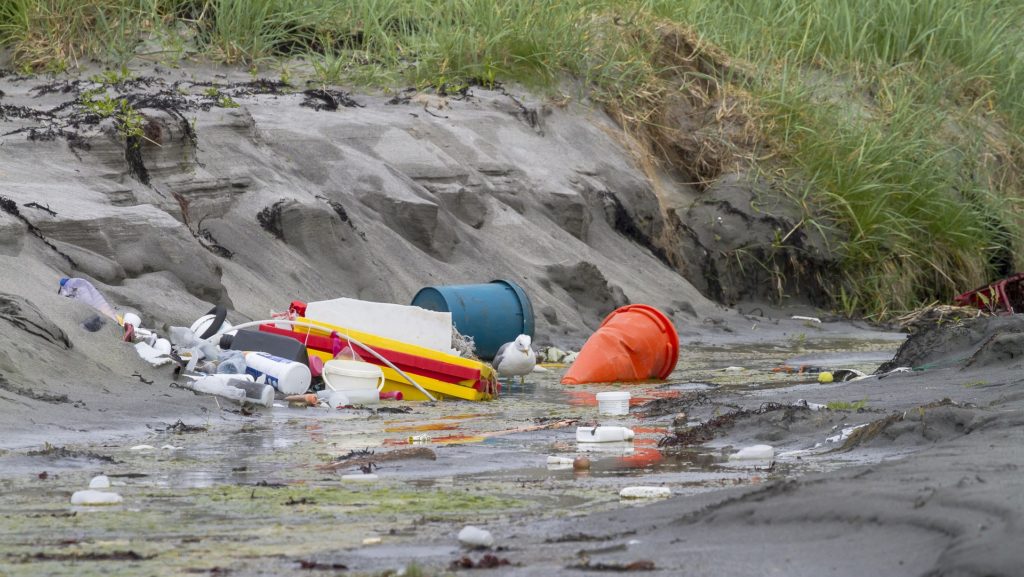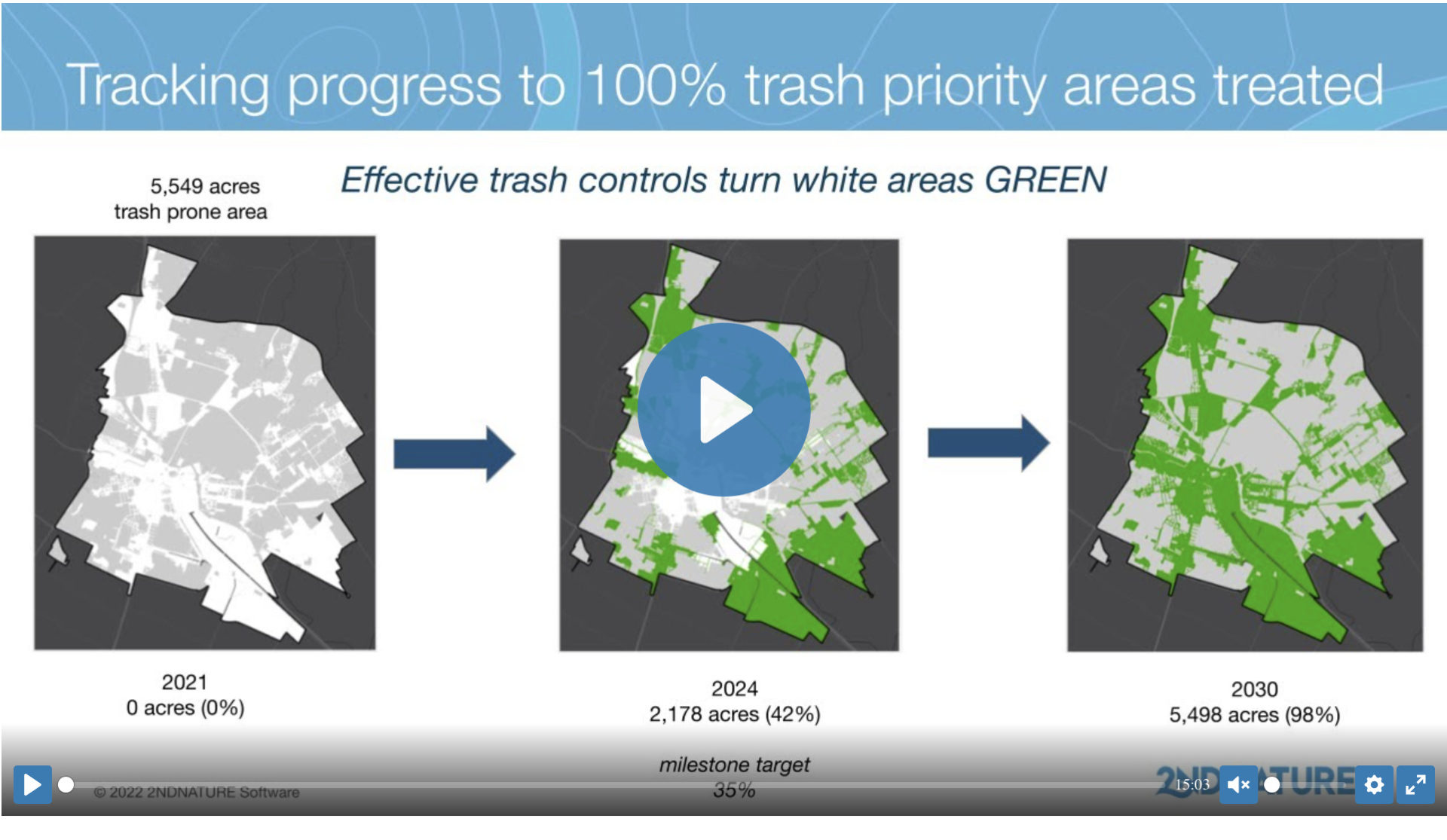The trash in our waterways poses a more significant threat to humans and wildlife than most people imagine. No one likes looking at garbage piled up near their favorite stream, but did you realize that it poses a dire threat to wildlife and humans?

The fast pass for toxic pollutants
Trash, litter, and other human-generated debris carry an array of toxic pollutants. Looking closely at the urban environment, litter and debris can be found everywhere, along the roadside, in vacant lots, and on the banks of streams. When it rains, trash accumulated on city streets flows into urban storm drain systems and local waterways. Pollutants attached to the trash can contaminate drinking water sources, spread bacteria and viruses, and move pesticides, heavy metals, and industrial by-products into aquatic ecosystems.
An estimated 8 million metric tons of waste end up in the world’s oceans yearly – the equivalent of dumping a garbage truck every minute, contributing to vast spinning gyres of debris like the well-known Great Pacific Garbage Patch. Plastic waste entangles animals and ends up in their stomachs. It breaks down into smaller particles called microplastics, which tiny organisms can ingest at the base of the freshwater food web. Once those toxins are in our water, they can readily be consumed or absorbed by fish and other wildlife and move up the food chain to humans.
Grab it before the water does
Sounds simple enough. But the most practical solution is to pick up the trash before it enters the urban stormwater systems and waterways. This means that part of the trash solution involves getting communities engaged in reducing the amount of trash coming from our stormwater systems and ensuring that cities are accountable for doing their part. Learning about trash generation and transport can be a pathway to understanding how all parts of watershed systems affect one another, how the impacts of human activities travel along stream networks, and how other pollutants of concern can damage the aquatic ecosystems that we all depend upon. It can serve as a gateway issue for communities to coalesce around and pursue watershed-wise policies, planning, and community actions.
Regulations to the rescue?
Recognition of the size of the trash problem has come with growing regulatory requirements for cities to reduce the trash across the US in places like California, New York, Hawaii. and Louisiana, with more state and local legislation in the works. Regulations typically require data collection to identify the locations and levels of trash problems throughout cities. With reliable data, cities can make informed decisions about where to implement structural and non-structural controls to reduce the trash in stormwater and progress reporting on their path to comply with regulations.
Several recent policy actions highlight the growing focus on trash generated from urban areas. The National Academies of Science published a report in 2022 outlining the need for better trash monitoring, progress tracking, and the use of technology. The EPA developed a national standard for monitoring trash accumulation in urban and riparian environments. The EPA’s Escaped Trash Assessment Protocol (ETAP) reference manual is a step-by-step guide to implementing that protocol. California has joined the growing list of states that have passed historic extended producer responsibility (EPR) legislation (CA SB 54) to shift the cost of recycling plastic packaging materials from consumers and local governments to producers of those materials.
It comes down to local action
What can local stormwater programs do about their trash problems and fast-approaching regulations? Get informed about your trash problems and get ahead of the curve. City and County stormwater programs are crucial in using data collection requirements to understand where litter-prone areas are within the city. With the correct data, the city can develop implementation strategies to prioritize investments to address local trash issues via street sweeping programs, community cleanup efforts, public education, and structural stormwater capture devices. Street sweeping programs and clean-up events can pick up trash and debris before it can enter waterways through stormwater runoff throughout the city, including community-valued areas like parks, rivers, and beaches. Education helps residents connect urban litter, polluted stormwater, and trashy waterways to local support and action. Stormwater structural controls such as bioretention systems and dry basins may be retrofitted to capture trash in stormwater runoff to keep it out of streams, lakes, and the ocean.
Stormwater programs need efficient ways to obtain reliable data that inform where to focus mitigation actions, quantify urban trash reduction effectiveness, and provide meaningful reporting of annual progress to regulators. To be successful, the strategies employed by stormwater programs will need to focus resources at locations where problems are most severe and progress needs to be communicated effectively.
Using technology to confront the challenge
This is precisely why 2NDNATURE created the Trash Compliance Module as a critical component of our stormwater information management system: to empower stormwater managers to develop effective strategies that keep trash out of their local waterways cost-effectively.
![]()
The 2NFORM stormwater platform provides an end-to-end digital solution for communities seeking to modernize their stormwater programs with better data collection, management, and analysis to identify improvement opportunities, allocate resources more efficiently, and track progress over time. The geospatial framework leverages maps and science-based analytics to turn required data collection into information that informs effective stormwater improvement strategies. The Trash Compliance Module provides a science-based approach for cities to document trash reduction efforts and measure improvements. It helps the growing list of communities across the US with trash regulatory requirements to identify their trash hot spots, focus actions where they are needed most, and report compliance to regulators. Like other 2NFORM modules, the embedded analytics produce reliable results based on published peer-reviewed science (Conley et al., 2019; Conley et al., 2022).
The underlying science, design, and functionality available to 2NFORM users directly address the data and technological barriers identified by the National Academies of Science identified in a 2022 report. Associated monitoring protocols and mobile apps align with the newly developed EPA monitoring standard for urban and riparian trash assessments. Data are organized around a common geospatial framework with other stormwater minimum control measure data, breaking down the data silos that typically create challenges for using these data together for analysis, mapping, and reporting.
Knowledge Precedes Action
Trash and litter delivered by stormwater degrade communities’ aesthetics, act as a conveyor for harmful pollutants, and significantly contributes to global oceanic trash gyres. City and County stormwater programs play a critical role in addressing these issues through the development of practical strategies. Trash is a tangible, visible water pollution problem. It is an issue to motivate, engage and educate residents on the broader opportunity for how better-managed stormwater can build a more resilient community. To make the connection between healthy waterways and trash mitigation actions, stormwater programs need reliable data and mapping tools to identify where the problems are, identify practical solutions, and track progress toward goals. The 2NDNATURE Trash Compliance Module can help stormwater programs make those connections crystal clear and empower them to chart a path toward trash-free urban waterways.



